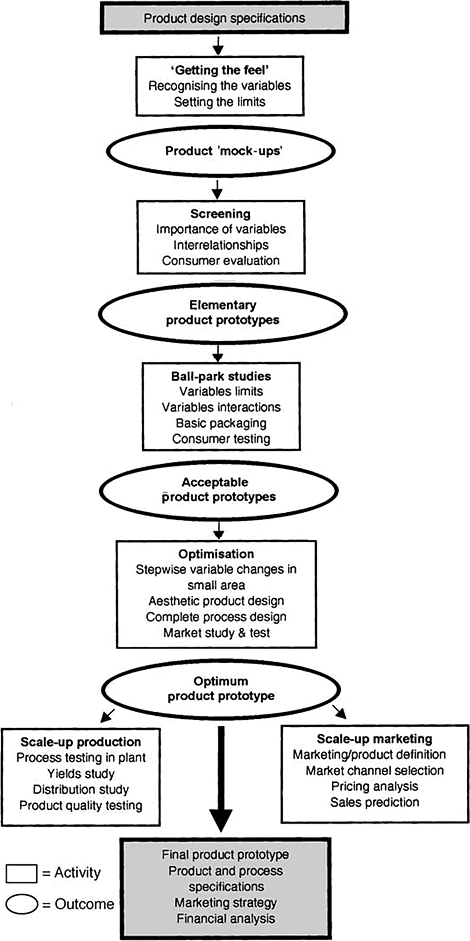FOOD
PRODUCT DEVELOPMENT
Mary Earle, Richard Earle and Allan Anderson |
| Loading
|
development |
|
||||
|
|
|
Part
2, Chapter 3
The product development process 3.2.1 Stages in product design and process development The stages of the product design and process development are shown in Fig.
3.8; the activities are in the boxes, the outcomes in the ovals.
 Fig. 3.8 Product design and process development: activities and outcomes. At the beginning of Stage 2, product design is the major part of the work, with process development considered in the design of the product. As the project progresses and the area for the product is more clearly defined, the study of the variables in the process becomes important so as to achieve the optimum product. The variables include both input and output variables.  Input variables: raw materials (type, quality, quantity) and processing Input variables: raw materials (type, quality, quantity) and processing (types of processing, processing conditions).  Output variables: product qualities and product yields. Output variables: product qualities and product yields.
The two main areas for research are formulation and processing; the first studying the type and quantities of raw materials and the second studying the effects of changing the processing conditions, but it is important that these are not studied separately as they are strongly interactive. The design is a continuous study of the relationships between the input variables and the product qualities, so that the final product is the optimum product under the conditions of the process. The prototype products are tested under the individual specifications set for the product design, so that product testing needs to be organised along with the product design and the processing experiments (Earle and Earle, 1999). Regular consumer testing of the product prototypes is necessary to confirm that the product has the characteristics identified in the product concept and not characteristics that are undesirable to the consumers. Seldom does product design and process development occur in a straight line as in Fig. 3.8. There is back cycling because the prototype product is not completely acceptable to the consumer or the costs are not within the cost limits, or the chosen equipment cannot produce the product at the right yield or quality. It is important in each of these steps that there are technical, consumer and cost testings (Earle and Earle, 2000). The costs develop in stages from an identification of the parts of the company's cost system for this type of product and the limits for the various costs. Usually at the early stages, the raw material costs, their limits on the formulation, and the general costs of manufacturing are identified. The product, packaging and processing costs can be determined during the experimentation for the optimum product. After yield results during the production scale-up have been obtained and costs of marketing predicted, the total costs can be assessed. |
|
 |